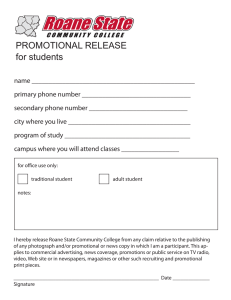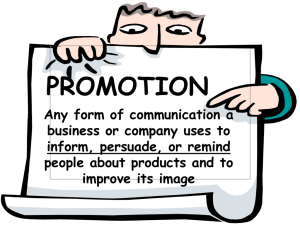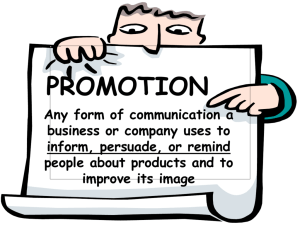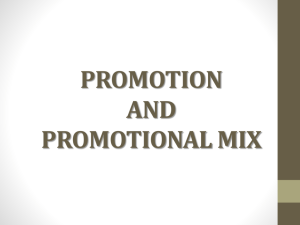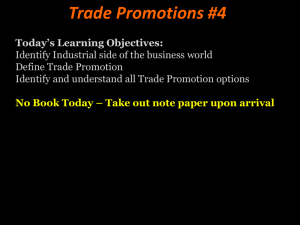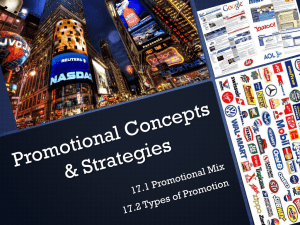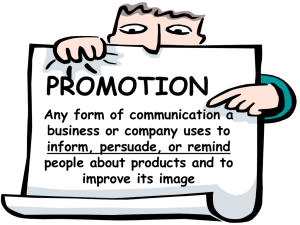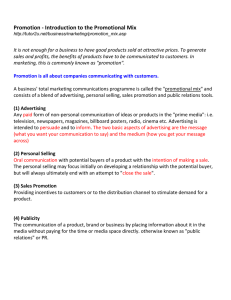Lesson Plan
advertisement
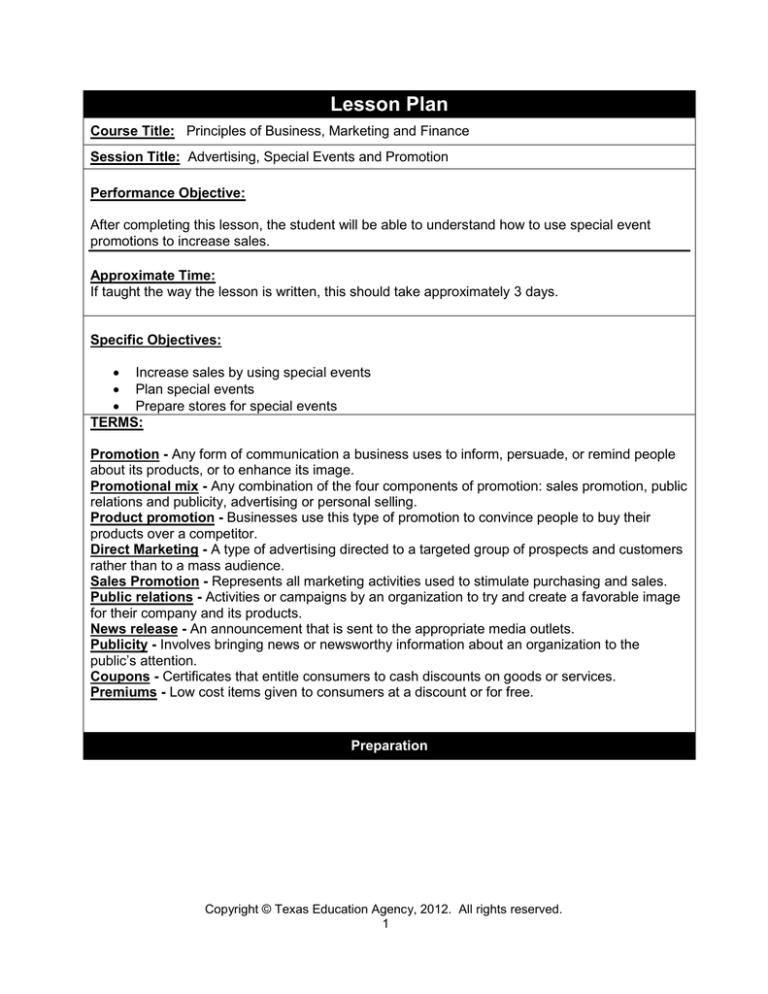
Lesson Plan Course Title: Principles of Business, Marketing and Finance Session Title: Advertising, Special Events and Promotion Performance Objective: After completing this lesson, the student will be able to understand how to use special event promotions to increase sales. Approximate Time: If taught the way the lesson is written, this should take approximately 3 days. Specific Objectives: Increase sales by using special events Plan special events Prepare stores for special events TERMS: Promotion - Any form of communication a business uses to inform, persuade, or remind people about its products, or to enhance its image. Promotional mix - Any combination of the four components of promotion: sales promotion, public relations and publicity, advertising or personal selling. Product promotion - Businesses use this type of promotion to convince people to buy their products over a competitor. Direct Marketing - A type of advertising directed to a targeted group of prospects and customers rather than to a mass audience. Sales Promotion - Represents all marketing activities used to stimulate purchasing and sales. Public relations - Activities or campaigns by an organization to try and create a favorable image for their company and its products. News release - An announcement that is sent to the appropriate media outlets. Publicity - Involves bringing news or newsworthy information about an organization to the public’s attention. Coupons - Certificates that entitle consumers to cash discounts on goods or services. Premiums - Low cost items given to consumers at a discount or for free. Preparation Copyright © Texas Education Agency, 2012. All rights reserved. 1 TEKS Correlations: This lesson, as published, correlates to the following TEKS. Any changes/alterations to the activities may result in the elimination of any or all of the TEKS listed. 130.112 (c) (10) The student understands how to increase sales by employing visual merchandising techniques and using special events to increase sales. 130.112 (c) (10) (D) Plan special events; and 130.112 (c) (10) (E) Prepare stores and departments for special events Interdisciplinary Correlations: English: 110.33(b)(1)(A) – Reading/Vocabulary Development …determine the meaning of grade-level technical academic English words in multiple content areas (e.g., science, mathematics, social studies, the arts) derived from Latin, Greek or other linguistic roots and affixes. 110.33(b)(1)(B) – Reading/Vocabulary Development ….analyze textual context (within a sentence and in larger sections of text) to draw conclusions about the nuance in word meanings. 110.33(b)(1)(C) – Reading/Vocabulary Development …infer word meaning through the identification and analysis of analogies and other word relationships. 110.33(b)(9)(C) – Reading/Comprehension of Informational Text/Expository Text …make and defend subtle inferences and complex conclusions about the ideas in text and their organizational patterns. 110.33(b)(11)(B) – Reading/Comprehension of Informational Text/Procedural Text …translate (from text to graphic or from graphic to text) complex, factual, quantitative or technical information presented in maps, charts, illustrations, graphs, timelines, tables and diagrams. 110.33(b)(12)(A) – Reading/Media Literacy …evaluate how messages presented in media reflect social and cultural views in ways different from traditional texts. Copyright © Texas Education Agency, 2012. All rights reserved. 2 110.33(b)(12)(B) – Reading/Media Literacy …evaluate the interactions of different techniques (e.g., layout, pictures, typeface in print media, images, text, sound in electronic journalism) used in multi-layered media. 110.33(b)(12)(C) – Reading/Media Literacy …evaluate the objectivity of coverage of the same event in various types of media. 110.33(b)(12)(D) – Reading/Media Literacy …evaluate changes in formality and tone across various media for different audiences and purposes. Occupational Correlation (O*Net – www.onetonline.org/ ) Job Title: Public Relations Specialist O*Net Number: 27-3031.00 Reported Job Titles: Communications Director, Communications Specialist, Media Relations Specialist Tasks: Respond to requests for information from the media or designate an appropriate spokesperson or information source. Study the objectives, promotional policies, or needs of organizations to develop public relations strategies that will influence public opinion or promote ideas, products, or services. Plan or direct development or communication of informational programs to maintain favorable public or stockholder perceptions of an organization's accomplishments or agenda. Soft Skills: Talking to others to convey information effectively. Giving full attention to what other people are saying, taking time to understand the points being made, asking questions as appropriate, and not interrupting at inappropriate times. Adjusting actions in relation to others' actions. Accommodations for Learning Differences: It is important that lessons accommodate the needs of every learner. These lessons may be modified to accommodate your students with learning differences by referring to the files found on the Special Populations page of this website. Teacher Preparation: Teacher will review the terms in the outline, Presentation and handouts to become familiar with lesson. References: Textbooks: Advertising & Integrated Brand Promotion. O’Guinn-Allen-Semenik. Thompson South-Western. AAP. Advertising- Business 2000 Townsley South-Western. Marketing Essentials, Glencoe – Copyright © Texas Education Agency, 2012. All rights reserved. 3 Instructional Aids: Projector/Presentation; Textbooks and Websites the instructors finds appropriate Materials Needed: 1. Printer Paper 2. Assignment handouts Equipment Needed: 1. Computers for teacher/students with Presentation and Internet access 2. Projector Learner Preparation: Explain to students that in this lesson they will be learning how the role of promotion and special events increase sales and help companies maintain the image they would like to portray to their customers. Introduction Introduction: (Day 1) ASK: Students to think about what types of products tend to have re-occurring special events or promotions tied to them. Discuss these products with class. ASK: Students to think of examples when a company did not promote a product or service enough, or promoted the product or service with the wrong message. Discuss examples with class. SAY: There are many types of promotions and special events. These events are created to reach as many customers (both existing and potential) as possible, in as many ways as possible. SHOW: (Using a projector) show students an image of a product that was promoted successfully and then an image of a product that was not promoted successfully. Discuss what each company did or could have done to help the success of the product. SAY: Companies rely on promotions to inform people about their products and services. Copyright © Texas Education Agency, 2012. All rights reserved. 4 Companies use special events and promotional techniques to enhance their public image and reputation and persuade people that their products are of value. Promotional goals must be set beforehand to ensure success. These goals must be specific and measurable. Outline Outline: Instructors can use the Presentation, slides, handouts, and note pages in conjunction with the following outline. MI Outline I. Promotions and Special Events A. Introduction 1. Product and special events. 2. Product Images and successful promotions 3. Public Image 4. Specific and measurable goals B. Guided Practice-Presentation presentation C. 1. Personal Selling 2. Advertising 3. Direct Marketing 4. Sales Promotion 5. Public Relations D. Independent Practice 1. Group activity 2. Research successful promotion 3. Compare and contrast with unsuccessful promotion E. Formal Assessment 1. Group Project 2. Create High School Special Event 3. Each member to cover one element of the Promotion Mix Notes to Instructor (Day 1) - Use Presentation as visual aid. After introduction, go through vocabulary terms and explain to class. Within the Presentation, explain the five components of the promotional mix. Make sure that you go over the notes with the students at the bottom of each slide. (Day 2 & 3) (Independent Practice) Have students break into groups and research/think of a successful promotion or special event that was widely publicized. Have them write down the details of what made this promotion successful. Then have them contrast it with a promotion/event that got really bad publicity. What could have been done differently? What kind of message was given? How was the Copyright © Texas Education Agency, 2012. All rights reserved. 5 media involved? Write down details and submit. (Formal Assessment) Keeping the students within the same groups, have them create a special event for their high school. (details below) Verbal Linguistic Logical Mathematical Visual Spatial Musical Rhythmic Bodily Kinesthetic Intrapersonal Interpersonal Naturalist Existentialist Application Guided Practice: Introduction and class discussion on products and promotions. (see above) Follow with details of the presentation including promotional mix. (Make sure to look at notes at the bottom of the presentation.) Independent Practice: Have students break into groups and research/think of a successful promotion or special event that was widely publicized. Have them write down the details of what made this promotion successful. Then have them contrast it with a promotion/event that got really bad publicity. What could have been done differently? What kind of message was given? How was the media involved? Write down details and submit. Summary Review: What are the key elements to the promotional mix? How important is good publicity? How are public relations key to the success of a company? Copyright © Texas Education Agency, 2012. All rights reserved. 6 Evaluation Informal Assessment: Instructor will be observant with students during group project. Instructor will move about the classroom setting, providing feedback and making sure that students are participating within their groups. Formal Assessment: In groups of 5, have students create a special event for their high school. Assign each member of the group to one of the five types of promotion. (personal selling, advertising, direct marketing, sales promotion, and public relations. Using notes, have each group give an oral presentation of their promotional strategies and details for the event. Extension Extension/Enrichment: Ask students how they think companies evaluate the success of a special event or promotion. Discuss with class Copyright © Texas Education Agency, 2012. All rights reserved. 7 High School Event Rubric Student Name: ________________ ________________ _____________ 20 15 10 5 or less Comprehension Student is able to accurately answer almost all questions posed by classmates about the topic. Student is able to accurately answer most questions posed by classmates about the topic. Student is able to accurately answer a few questions posed by classmates about the topic. Student is unable to accurately answer questions posed by classmates about the topic. Preparedness Student is completely prepared and has obviously rehearsed. Student seems pretty prepared but might have needed a couple more rehearsals. The student is somewhat prepared, but it is clear that rehearsal was lacking. Student does not seem at all prepared to present. Enthusiasm Facial expressions and body language generate a strong interest and enthusiasm about the topic in others. Speaks clearly and distinctly all (100-95%) of the time, and mispronounces no words. Facial expressions and body language sometimes generate a strong interest and enthusiasm about the topic in others. Facial expressions and body language are used to try to generate enthusiasm, but seem somewhat faked. Very little use of facial expressions or body language. Did not generate much interest in topic being presented. Speaks clearly and distinctly all (10095%) of the time, but mispronounces one word. Speaks clearly and distinctly most (9485%) of the time. Mispronounces no more than one word. Often mumbles or cannot be understood OR mispronounces more than one word. Stands up straight, looks relaxed and confident. Establishes eye contact with everyone in the room during the presentation. Stands up straight and establishes eye contact with everyone in the room during the presentation. Sometimes stands up straight and establishes eye contact. Slouches and/or does not look at people during the presentation CATEGORY Speaks Clearly Posture and Eye Contact Copyright © Texas Education Agency, 2012. All rights reserved. 8
